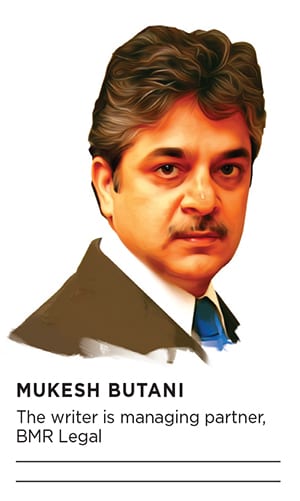Reinvigorate growth and fight black money: Managing partner, BMR Legal


It will be interesting to see how the government balances three expected priorities: Focus on welfare schemes, interests of the common man and ease of doing business
There are great expectations from Budget 2017, which comes close on the heels of the central government’s move to demonetise high-value currency notes.
The government is expected to act swiftly, so that India regains its economic momentum, and take further measures to fight the menace of black money.
While it is important that measures are announced to arrest any material slowdown in GDP growth (estimates expect a year-on-year slide of between 0.5 and 2 percentage points this fiscal), it is equally crucial to ensure that India stays on course to bring a cultural shift towards digitisation to operate in a corruption-free environment.
Despite the ruling National Democratic Alliance’s relentless focus on improving the policy and regulatory environment for businesses, India is placed at a low 130 among 190 countries in the World Bank’s Ease of Doing Business rankings for 2017. Realising Prime Minister Narendra Modi’s vision of positioning India among the top 50 countries in this list, therefore, seems to be an arduous goal. Even as there is a targeted focus on eradicating corruption and red-tapism, increasing transparency and streamlining processes is needed to progress on parameters such as getting construction permits, registering property, paying taxes, resolving insolvencies and enforcing contracts.
Equally important is the need to improve the perception about corruption. The NGO Transparency International’s proxy indicator, Corruption Perceptions Index, that ranks nations on the basis of their perceived levels of corruption, places India at 76 out of 168 countries.
An unprecedented battle against corruption has been heralded with demonetisation. The exercise, however, is incomplete without addressing electoral funding, land registration and police reforms, which contribute materially to perceptions of corruption.
Our political leadership has usually been wary of tackling issues that impact electoral funding and related governance among political institutions. To boost public confidence, it is paramount to rectify this fundamental structural flaw, which leads to a moral vacuum in the endeavour to fight black money.
The demonetisation drive is expected to be followed by a crackdown on benami transactions and unaccounted wealth. One major sink of black money is the real estate sector, conveniently facilitated by unclear titles. Clear titles will curb fraudulent property deals and institutional reforms, particularly at the state level, will reduce artificial scarcity of land for businesses and development.
Demonetisation signals a strong push for India to transition to a cashless society. Digital financial inclusion has economic implications in boosting consumption and increasing domestic aggregate demand and helps the government in expanding the tax net and raising more resources. Demonetisation signals a strong push for India to transition to a cashless society
Demonetisation signals a strong push for India to transition to a cashless society
Image: Eyeswideopen / Getty Images
According to a study conducted in 70 countries between 2011 and 2015 by global ratings agency Moody’s, a 1 percent increase in debit or credit card usage on average translates to a 0.06 percent increase in consumption and adds $296 billion to the GDP, which is the equivalent of 2.6 million jobs on average per year over a five-year period, or about 0.4 percent of total employment.
For India to reap real economic benefits and trigger a rapid transition towards a cashless society, three key elements are imperative: Expanding financial literacy to rural households, boosting public confidence on cyber security for electronic payments and creating a pull by incentivising electronic payments through tax breaks.
The passage of the Goods and Services Tax (GST) legislation during the budget session of Parliament is expected to lay down a definite implementation course to India’s biggest tax reform. Besides streamlining the tax system and expanding the tax base, GST will offer crucial economic support in enhancing growth. While most estimates indicate the improvement in GDP to be about 1.5 to 2 percentage points, much of the positive impact is expected to come over a long term as the unified tax system will initially increase the tax burden on the services sector, which accounts for roughly 60 percent of India’s GDP. Therefore, there is a strong case for rebalancing the tax policy with adjustments in direct taxes to provide an immediate boost on the consumption and investments side.
As an outcome of demonetisation and onboarding of GST next fiscal, the tax base is likely to expand materially, laying the foundation for higher tax revenues in the years to come. This would provide the necessary fiscal room to increase expenditure on major thrust areas in infrastructure sectors, including railways, ports and renewable energy.
Developments in the banking sector after a clean-up of non-performing assets and demonetisation-led capitalisation of banks, especially public sector banks, augur well for the future. Interest rate cuts will be anticipated, translating into cheaper loans and recovery in credit off-take to boost economic growth.
From a global perspective, Budget 2017 should weigh in the possibilities of faster-than-anticipated interest rate hikes by the US Federal Reserve, rebalancing of the global economy following the protectionist policies of US president-elect Donald Trump, Brexit-sparked uncertainties and a rebound in crude oil prices.
It will be interesting to see how the government keeps a balance between three expected priorities: Focus on welfare schemes, interests of the common man and ease of doing business.
Budget 2017 marks a shift from previous years—advancement of the date by a month, merger of the railway budget and the removal of the distinction between plan- and non-plan expenditure. It will therefore be an event to witness.
First Published: Jan 31, 2017, 06:42
Subscribe Now